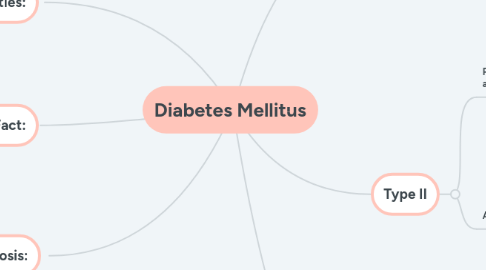
1. Educational Opportunities:
1.1. Teach patient about Diabetes and how to manage disease process.
1.2. Teach patient about insulin, how to administer, when to administer, and where to administer.
1.3. Teach patient signs and symptoms of hypo and hyperglycemia and what to do if they experience either.
2. Important Fact:
2.1. Type I diabetes is lifelong and will require consistent management of treatment.
3. Nursing Diagnosis:
3.1. Risk for Unstable Blood Glucose
3.2. Deficient Knowledge
3.3. Risk for impaired skin integrity
4. Type I
4.1. Patho: Pancreas is not producing insulin on it's own. Creating insulin dependence.
4.2. Assessment:
4.2.1. Hypoglycemia:
4.2.1.1. Signs/Symptoms: Diaphoresis, Tachycardia, Confusion, Fatigue, Dizzy
4.2.1.2. Diagnostics: Blood Glucose <70, HbA1C <6% (normal), 6-6.4% (prediabetic), >6.5% (diabetic)
4.2.2. Hyperglycemia:
4.2.2.1. Signs/Symptoms: Polydipsia, Polyuria, Polyphagia, headache, blurred vision and fatigue.
4.2.2.2. Diagnostics: Blood Glucose >110, HbA1C <6% (normal), 6-6.4% (prediabetic), >6.5% (diabetic), Ketones 0.6-1.5 mmol/L, Elevated levels of glucose in urine.
5. Type II
5.1. Patho: Decreased insulin production and action, increased insulin resistance.
5.2. Assessment:
5.2.1. Hypoglycemia:
5.2.1.1. Signs/Symptoms: Diaphoresis, Tachycardia, Confusion, Fatigue, Dizzy
5.2.1.2. Diagnostics: Blood Glucose <70, HbA1C <6% (normal), 6-6.4% (prediabetic), >6.5% (diabetic)
5.2.2. Hyperglycemia:
5.2.2.1. Signs/Symptoms: Polydipsia, Polyuria, Polyphagia, headache, blurred vision and fatigue.
5.2.2.2. Diagnostics: Blood Glucose >110, HbA1C <6% (normal), 6-6.4% (prediabetic), >6.5% (diabetic), Ketones 0.6-1.5 mmol/L, Elevated levels of glucose in urine.
6. Nursing Interventions:
6.1. Hypoglycemia:
6.1.1. Assess patient's level of consciousness. (If conscious)-give 15 g simple carb by mouth. (If unconscious- administer Dextrose 50% IV.
6.1.2. Assess Blood Glucose level every 15 minutes after giving 15 grams simple carbohydrate.
6.1.3. Educate patient about signs/symptoms of hypoglycemia and how to prevent it.
6.2. Hyperglycemia:
6.2.1. Administer insulin as ordered
6.2.2. Assess patient's blood glucose after onset of insulin.
6.2.3. Assess patient's electrolyte levels due to polyuria and polydipsia (can cause fluid imbalances).
